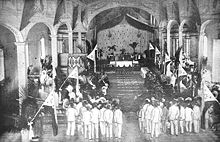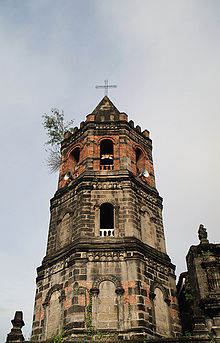Barasoain Church
| Barasoain Church | |
|---|---|
| Our Lady of Mount Carmel Parish | |
 Aerial view of Barasoain Church, 2018 | |
| 14°50′48″N 120°48′46″E / 14.846649°N 120.812679°E | |
| Location | Malolos, Bulacan |
| Country | Philippines |
| Denomination | Catholic |
| Website | http://www.barasoainchurch.org |
| History | |
| Status | Parish church |
| Founded | 31 August 1859 |
| Dedication | Our Lady of Mount Carmel |
| Relics held | John Paul II |
| Associated people | Emilio Aguinaldo Felipe Calderon Pedro Paterno |
| Architecture | |
| Functional status | Active |
| Heritage designation | Seat of the First Philippine Republic |
| Designated | 1 August 1973 |
| Architect(s) | Miguel Magpayo |
| Architectural type | Parish church |
| Style | Baroque |
| Groundbreaking | 1885 |
| Completed | 1888 |
| Specifications | |
| Number of towers | 1 |
| Materials | Adobe and concrete |
| Bells | 8 |
| Administration | |
| Division | Vicariate of Malolos |
| Province | Ecclesiastical Province of Manila |
| Diocese | Roman Catholic Diocese of Malolos |
| Clergy | |
| Bishop(s) | Most Rev. Dennis Cabanada Villarojo |
| Rector | Rev. Fr. Dario V. Cabral |
| Vicar(s) | Rev. Fr. Ronald Rey H. Mangon |
 | |
Barasoain Church (officially as the Our Lady of Mount Carmel Parish) is a Roman Catholic church built in 1888[1] in Malolos, Bulacan.[2] It is about 42 kilometers away from Manila. Having earned the title as the "Cradle of Democracy in the East, the most important religious building in the Philippines",[3] and the site of the First Philippine Republic, the church is proverbial for its historical importance among Filipinos.
Etymology
The term "Barasoain" was derived from Barásoain in Navarre, Spain to which the missionaries found the place in Malolos in striking similarity. When the Filipino revolution broke out, the Spanish authorities coined the term "baras ng suwail," which means "dungeon of the defiant" because the church was a meeting place for anti-Spanish and anti-colonial illustrados.[4]
History

Barasoain was known before as "Bangkal" a part of Encomienda of Malolos integrated by Miguel Lopez de Legaspi with the town of Calumpit on April 5, 1572. When the Augustinian friars founded the Town of Malolos in 1580 as an independent town, Bangkal became one of the villages of Malolos under the jurisdiction of the town church. A hermitage made of nipa and bamboo was constructed near the river between Maluslos (Malolos poblacion) and Barasoain for the people of Bangkal. In that same year, Malolos Friar Curate and Vicario Foraneo Fray Agustin Carreno, OSA established the first chapel at the old Ermita of the old Cemetery of Malolos. Abandoned in 1680, it served as the temporary visita of Barasoain, located in front of the Casa Tribunal (Presidencia), which is now commonly called "Casa Real de Malolos." A big fire in the 17th century destroyed the new church.
Another church building was commissioned and constructed on a new site, its present location—corner of Paseo del Congreso and Antonio Bautista streets. Under the supervision of Rev. Fr. Francisco Royo, O.S.A., the new church was built, made of light materials. In 1884, during the celebration of the Flores de Mayo (Nuestra Señora del Carmen), Patroness of the Parish, the temporary church was burned.[5]
From 1630 to 1859, priests serving in Barasoain were from the nearby church, the mother church of the town which is Parroquia de la Inmaculada Concepcion de Malolos. Since the formal establishment of Barasoain as an independent parish to Malolos Church in 1859, several priests were assigned by the Augustinian Order, and later by the Archdiocese of Manila and Diocese of Malolos.
The separation of Barasoain and the construction of the church
In 1859, Barasoain was separated from Malolos. As a new town and parish, the Our Lady of Mt. Carmel was deemed to be its patroness. Fr. Francisco Arriola, was appointed first parish priest on June 1, 1859, built the convent. A small ermita, constructed by Fr. Melchor Fernandez in 1816 while he was parish priest of Malolos (1816–1840), served as temporary parish church. One of the existing bells bears the year 1870. It was installed by Fr. Emterio Ruperez, and it was donated by the “principalia (sic) of Malolos.” The bell was also dedicated to the Our Lady of Mt. Carmel of Barasoain. Fr. Francisco Royo replaced the temporary chapel with a hewn stone church built between 1871 and 1878. This was soon destroyed by fire. The only remnant of this church is one of its bells, installed by Fr. Royo on February 30, 1873 and dedicated to St. Francis Xavier. Fr. Juan Giron who succeeded him, used the chapel of the cemetery until this one, too, was destroyed by the earthquakes of 1880. Fr. Giron then built temporary chapel of nipa and bamboo which was burned down in 1884, during the solemn celebrations of the feast of Our Lady of Mt. Carmel.
In 1885, Fr. Giron hired the services of contractor by the name of Miguel Magpayo and started the construction of a massive church made of masonry and bricks. The church was completed under Fr. Giron’s supervision. Jorde does not specify the year of its completion; he says only that, “at the time it was completed the pockets of Fr. Giron were drained.” In 1889, Fr. Martin Arconada started the construction of the tower and the restoration of the convent. Three bells were installed in 1897. One of them is dedicated to St. Martin, Bishop, and was donated by Fr. Martin Arconada. In 1894, Fr. Miguel de Vera undertook another restoration of the convent.


Philippine Revolution and the Malolos Congress
As tensions were brewing between the Filipino revolutionaries and the Americans who have arrived in the country in the wake of the Spanish–American War, the Philippine Revolutionary Government under the leadership of Emilio Aguinaldo decided to move the capital north from Cavite to Malolos in Bulacan. Plans were made to write a new constitution for the soon to be proclaimed Philippine Republic; Barasoain Church was chosen to be the site of the First Philippine Congress, otherwise known as the Malolos Congress, which convened on September 15, 1898 to draft what would become the Malolos Constitution.
On January 21, 1899, the Malolos Constitution was ratified. This paved way for the formal inauguration of the First Philippine Republic on January 23, 1899)[6] with Emilio Aguinaldo taking oath as president. But the outbreak of the Philippine-American War on February 4 brought the republic into a crisis. The Malolos Congress held its last session on the last week of February as the Aguinaldo government left Malolos and transferred the capital to Nueva Ecija.
On March 31, 1899, the American forces captured Malolos and Barasoain as they were placed under American control.
Reunited with Malolos and subsequent events
In 1903, the town of Barasoain was abolished as the former town was decreed to be reunited with Malolos.
By Presidential Decree No. 260, Barasoain Church was proclaimed as a National Shrine by President Ferdinand Marcos on August 1, 1973.[7] A museum was opened at the old convent of the church which is being managed by the National Historical Commission of the Philippines.
In the wake of the 1998 Philippine Centennial celebrations, the church became the venue for the inauguration of Joseph Estrada on June 30, 1998.[4]
Philippine Bill Issue
Before 2002, the image of the church has been depicted in certain monetary bills, namely the English series one peso bill and the Pilipino, Ang Bagong Lipunan, and both the 1985 and 1997 New Design series ten peso bill together with an image of Apolinario Mabini (Andres Bonifacio on the 1997 version) on the other side. However, it was replaced by a ten-peso coin without the representation of the church. In 2009, local priests and Laban ng Bulacan movement officials, led by their chairman John Paul Albert Limpo, initiated a signature campaign to appeal to the Philippine Bangko Sentral restoring at least the image of the church in any present Philippine bill.[8]
After three years of petition, in December 2010, upon the issuance of the "New Generation Currency" series for Philippine banknotes, the Barasoain Church was featured again, this time in the 200-peso denomination until 2017 when it was replaced with the scene of the opening of the Malolos Congress.[9]
References
- ^ "Bulacan". Travel Global Pinoy. Globalpinoy.com. Archived from the original on 2014-11-03. Retrieved 2007-11-18.
- ^ Watson, Todd (27 July 2013). "God in the Philippines". Inside Investor. Retrieved 31 July 2013.
- ^ Marquez, Teodoro S. (1968). "Malolos, Bulacan and Philippine Nationalism: Collected Writings". TSM Books and Souvenirs Enterprises and Agency Services: 4. Retrieved 2007-12-02.
{{cite journal}}: Cite journal requires|journal=(help) - ^ a b "Other facts about Barasoain". Geocities. Yahoo.com. Archived from the original on 2008-03-04. Retrieved 2007-11-18.
- ^ "National Historical Commission Of The Philippines | Republika Ng Pilipinas". Nhcp.gov.ph. Retrieved 2014-06-27.
- ^ "Barasoain church Historical Landmark". National Historical Institute. Nhi.gov.ph. Archived from the original on 24 November 2007. Retrieved 2007-11-18.
- ^ "Presidential Decree No. 260". Lawphil.net. Archived from the original on 24 November 2007. Retrieved 2007-11-18.
- ^ Reyes, Carmela (2007-10-16). "Priest wants Barasoain Church depicted in RP money as before". Breaking News/Region. Inquirer.net. Archived from the original on 18 October 2007. Retrieved 2007-11-18.
- ^ "Newscore". Newscoreonline.blogspot.com. Retrieved 2014-06-27.



